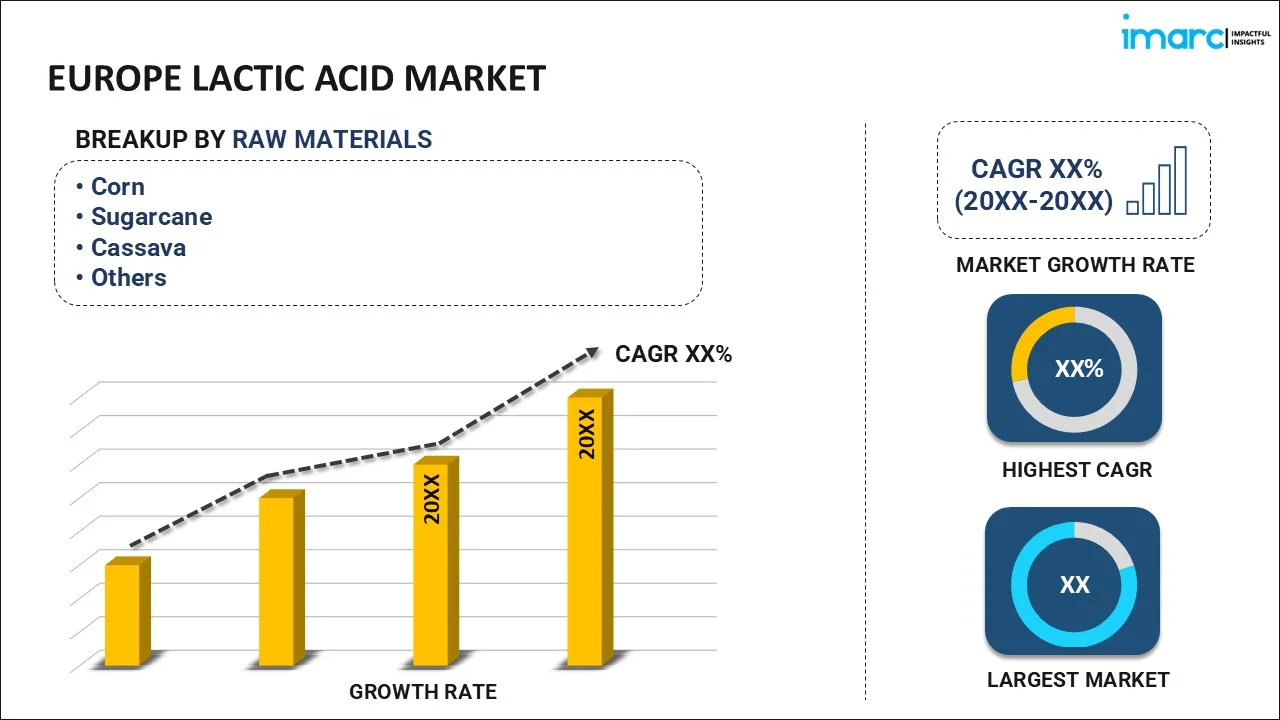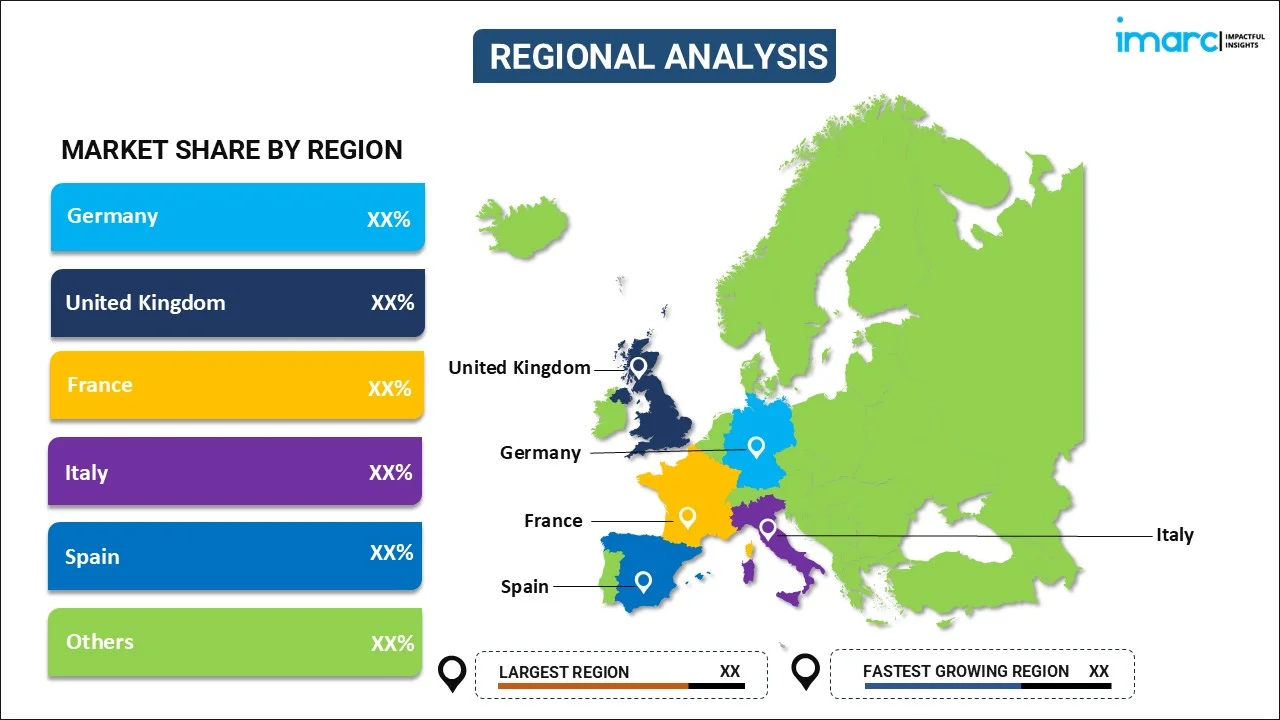
Europe Lactic Acid Market Size, Share, Trends and Forecast by Raw Material, Form, Application, and Region, 2025-2033
Europe Lactic Acid Market Overview:
The Europe lactic acid market size reached 0.45 Million Tons in 2024. Looking forward, IMARC Group expects the market to reach 0.88 Million Tons by 2033, exhibiting a growth rate (CAGR) of 7.70% during 2025-2033. The market is witnessing significant growth, driven by the increasing demand for bio-based lactic acid and expanding applications in bioplastics and packaging.
|
Report Attribute
|
Key Statistics
|
|---|---|
|
Base Year
|
2024 |
|
Forecast Years
|
2025-2033
|
|
Historical Years
|
2019-2024
|
| Market Size in 2024 | 0.45 Million Tons |
| Market Forecast in 2033 | 0.88 Million Tons |
| Market Growth Rate (2025-2033) | 7.70% |
Europe Lactic Acid Market Trends:
Increasing Demand for Bio-Based Lactic Acid
An increased demand for bio-based lactic acid represents one of the key factors driving the European lactic acid market growth. With the growing significance of sustainability in industries, there's an observable shift towards renewable and green production methods. Bio-based lactic acid is produced from renewable raw materials such as corn and sugarcane; hence, it is seen to have a low environmental impact as compared to petrochemical-derived lactic acid. More so, the European Union has introduced encouraging policies for bio-based products, such as the Green Deal and the Circular Economy Action Plan. These policies enforce conditions that promote biobased and renewable materials in various sectors like pack food like textiles. For instance, in May 2024, CBE JU announced that it has awarded €215 million to 396 beneficiaries for circular bio-based project implementation, such as bio-based lactic acid. Such projects replaced fossil-based products and encouraged innovative ways of less reliance or imports and ring jobs, as ring jobs are high in rural areas.Increasingly, manufacturers have been working on greener methods of production by working with renewable resources and waste. The increased pressure to meet carbon footprints and sustainability goals has also increased the requests for lactic acid sourced from natural resources. Such demands have also received support from advances in fermentation technology as ways to increase the efficiency of bio-based lactic acid production. There will be increasing future potentials in the demand of bio-based lactic acid as firms and customers will continuously prefer sustainable ways of carrying out their activities in various industries; thus, resulting in many eco-conscious formulations in products.
Expanding Application in Bioplastics and Packaging
Another key trend affecting the European lactic acid industry is the increased usage of lactic acid in bioplastics and packaging applications. Lactic acid bio-based material, polylactic acid (PLA), helps consumers to adopt the biodegradable form of plastic due to its environmentally friendly characteristics. For example, in 2024, Emigrates Biotech announced that it has awarded Sulzer, the Swiss industrial and manufacturing firm, the technology for the implementation of the forthcoming plant to produce 160,000 tonnes of PLA in the UAE, indicative of the venture being the largest worldwide. The plant intends to utilize feedstock from plant sources to produce bioplastics sustainably. The growing trend confirms that the industry is utilizing more PLA in its packaging materials. PLA has many advantages, one of which is that it is compostable and does not leave any harmful residues, promoting its use in applications like packaging. Most noticeable is demand from both sectors, food and beverage, as these companies are slowly shifting toward compostable and recyclable packaging solutions. European legislation, like the EU's single-use plastic ban, and the Circular Economy Action Plan, push companies to search for alternatives to plastic packaging. Lactic acid-based bioplastics, like PLA, can be positioned as a key solution to control plastic waste and increase recycling rates. These regulatory frameworks are expected to continue driving growth in lactic acid applications in packaging. New improvements in the material properties, including high thermal endurance and enhanced mechanical strength, broaden the usage potential of PLA in many more applications outside packaging, for example, in the automotive and textile sectors. This broadening application base will further reiterate lactic acid's role as a major future polymer in sustainable materials in Europe.
Europe Lactic Acid Market Segmentation:
IMARC Group provides an analysis of the key trends in each segment of the market, along with forecasts at the region/country level for 2025-2033. Our report has categorized the market based on raw material, form, and application.
Raw Material Insights:

- Corn
- Sugarcane
- Cassava
- Others
The report has provided a detailed breakup and analysis of the market based on the raw material. This includes corn, sugarcane, cassava, and others.
Form Insights:
- Liquid
- Solid
A detailed breakup and analysis of the market based on the form have also been provided in the report. This includes liquid and solid.
Application Insights:
- Industrial
- Food and Beverages
- Pharmaceuticals
- Personal Care
- Polylactic Acid (PLA)
- Others
A detailed breakup and analysis of the market based on the application have also been provided in the report. This includes industrial, food and beverages, pharmaceuticals, personal care, polylactic acid (PLA), and others.
Regional Insights:

- Germany
- France
- United Kingdom
- Italy
- Spain
- Others
The report has also provided a comprehensive analysis of all the major regional markets, which include Germany, France, United Kingdom, Italy, Spain, and others.
Competitive Landscape:
The market research report has also provided a comprehensive analysis of the competitive landscape. Competitive analysis such as market structure, key player positioning, top winning strategies, competitive dashboard, and company evaluation quadrant has been covered in the report. Also, detailed profiles of all major companies have been provided.
Europe Lactic Acid Market News:
- In November 2024, TripleW, a pioneer in circular chemistry, relocated its demonstration plant to the NextGen Demo site at the Port of Antwerp. The project, focused on producing lactic acid from food waste, supports the transition to a circular, climate-neutral economy. The port also launched a call for innovative companies.
- In December 2023, Sulzer launched SULAC™, a new technology for lactide production, completing its portfolio for manufacturing PLA, an eco-friendly bioplastic. SULAC™ converts lactic acid to lactide, addressing supply limitations. The technology enhances operational efficiency and enables PLA producers to create high-quality, sustainable biopolymer grades, supporting circular plastics.
Europe Lactic Acid Market Report Coverage:
| Report Features | Details |
|---|---|
| Base Year of the Analysis | 2024 |
| Historical Period | 2019-2024 |
| Forecast Period | 2025-2033 |
| Units | Million Tons |
| Scope of the Report |
Exploration of Historical Trends and Market Outlook, Industry Catalysts and Challenges, Segment-Wise Historical and Future Market Assessment:
|
| Raw Materials Covered | Corn, Sugarcane, Cassava, Others |
| Forms Covered | Liquid, Solid |
| Applications Covered | Industrial, Food and Beverages, Pharmaceuticals, Personal Care, Polylactic Acid (PLA), Others. |
| Regions Covered | Germany, France, United Kingdom, Italy, Spain, Others |
| Customization Scope | 10% Free Customization |
| Post-Sale Analyst Support | 10-12 Weeks |
| Delivery Format | PDF and Excel through Email (We can also provide the editable version of the report in PPT/Word format on special request) |
Key Questions Answered in This Report:
- How has the Europe lactic acid market performed so far and how will it perform in the coming years?
- What is the breakup of the Europe lactic acid market on the basis of raw material?
- What is the breakup of the Europe lactic acid market on the basis of form?
- What is the breakup of the Europe lactic acid market on the basis of application?
- What is the breakup of the Europe lactic acid market on the basis of region?
- What are the various stages in the value chain of the Europe lactic acid market?
- What are the key driving factors and challenges in the Europe lactic acid?
- What is the structure of the Europe lactic acid market and who are the key players?
- What is the degree of competition in the Europe lactic acid market?
Key Benefits for Stakeholders:
- IMARC’s industry report offers a comprehensive quantitative analysis of various market segments, historical and current market trends, market forecasts, and dynamics of the Europe lactic acid market from 2019-2033.
- The research report provides the latest information on the market drivers, challenges, and opportunities in the Europe lactic acid market.
- Porter's five forces analysis assist stakeholders in assessing the impact of new entrants, competitive rivalry, supplier power, buyer power, and the threat of substitution. It helps stakeholders to analyze the level of competition within the Europe lactic acid industry and its attractiveness.
- Competitive landscape allows stakeholders to understand their competitive environment and provides an insight into the current positions of key players in the market.
Need more help?
- Speak to our experienced analysts for insights on the current market scenarios.
- Include additional segments and countries to customize the report as per your requirement.
- Gain an unparalleled competitive advantage in your domain by understanding how to utilize the report and positively impacting your operations and revenue.
- For further assistance, please connect with our analysts.
 Inquire Before Buying
Inquire Before Buying
 Speak to an Analyst
Speak to an Analyst
 Request Brochure
Request Brochure
 Request Customization
Request Customization




.webp)




.webp)












